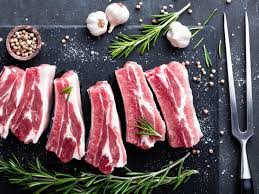When you walk down the meat aisle, you might find yourself wondering: Is pork red meat or white meat? This question isn’t as straightforward as it seems, and opinions vary widely. While pork is technically classified as red meat, certain cuts share nutritional profiles closer to white meat like chicken. Given that pork is the most widely consumed meat globally, it’s worth diving deeper into this classification debate to understand what really sets pork apart.

Understanding the Color Divide: What Makes Meat Red or White?
The difference between red and white meat largely comes down to one key factor: the amount of a protein called myoglobin in the muscle fibers. Myoglobin is responsible for storing and transporting oxygen within muscles, and it’s what gives meat its characteristic color.
When myoglobin is exposed to oxygen, it turns a bright red — which is why red meats like beef have their signature deep hue. White meat, on the other hand, contains much less myoglobin, resulting in a paler appearance.
But it’s not quite that simple. Various factors can affect meat color, including the animal’s age, species, diet, activity level, and even how the meat is packaged or processed. For example, muscles that get more use have more myoglobin because they need more oxygen, leading to darker meat. That’s why the meat from a chicken’s legs tends to be darker than breast meat.
According to food scientists, the typical raw meat colors range from the cherry red of beef, to the grayish-pink of pork, to the pale pink of veal, while poultry often has a bluish-white to yellowish tint. This spectrum is all connected to myoglobin levels and the muscle function of the animal.
Scientific and Regulatory Classification: Pork Is Red Meat
From a scientific and regulatory standpoint, pork is classified as red meat. The United States Department of Agriculture (USDA), along with many other food authorities worldwide, places pork in the red meat category. The main reasons are twofold:
Myoglobin Content: Pork contains more myoglobin than poultry and fish. While it may not look as bright red as beef, the myoglobin concentration is higher than in white meat, placing it in the red meat category.
Animal Classification: Pigs are farmed as livestock, just like cattle, lamb, and veal. All meat from these animals is generally considered red meat.
This classification holds true despite the fact that when cooked, some pork cuts appear lighter and less red than traditional red meats. The biological and chemical markers remain clear indicators of pork’s red meat status.
Culinary Perspectives: Pork as “The Other White Meat”
Culinary traditions often take a different approach to pork. In kitchens and food marketing campaigns, pork has been positioned as a white meat — especially lean cuts.
This perspective gained traction thanks in part to a highly successful promotional campaign launched by the National Pork Board in the late 1980s. Backed by the USDA’s Agricultural Marketing Service, the campaign popularized the slogan: “Pork. The Other White Meat.” The goal was to encourage consumers to view pork as a lean, healthier alternative to red meat, emphasizing its milder color and flavor.
Cooks and chefs tend to categorize meat based on how it looks and tastes both raw and cooked. Since many cuts of pork can look and feel more like chicken in texture and color — especially lean loin cuts — it’s easy to see why pork earned this culinary classification.
Nutritional Similarities Between Pork and White Meat
Certain cuts of pork, like tenderloin and loin chops, are leaner and nutritionally closer to white meat such as chicken or turkey. They tend to be lower in fat and calories compared to fattier cuts of red meat like ribeye or brisket.
This similarity in nutrition, combined with the mild flavor and light color of cooked pork, helps blur the lines for many consumers who prefer to think of pork as a white meat option.
What Does This Mean for You?
Ultimately, whether pork is red or white meat depends on the lens you use: science or culinary tradition.
Scientific Lens: Pork is red meat because of its higher myoglobin content and classification as livestock.
Culinary Lens: Pork is often treated as white meat because of its lighter appearance, mild flavor, and similarity to chicken in certain cuts.
Both perspectives are valid, and understanding them helps you make informed decisions about your diet.
The Bottom Line
Pork occupies a unique place in the meat world. It’s scientifically a red meat due to its myoglobin content and animal classification, yet culinarily it often behaves like white meat, especially when considering lean cuts. This dual identity is why the phrase “The Other White Meat” has resonated for decades.
Whether you prefer pork classified one way or the other, it’s undeniable that pork’s versatility, flavor, and nutritional profile make it a popular choice around the globe. So, the next time you’re deciding what meat to cook, remember that pork can offer the best of both worlds — bridging the gap between red and white meat in your meals.


I always thought pork was white meat, so this article really cleared things up for me. It’s interesting how science and culinary traditions differ on this
Great explanation! I’ve seen pork called ‘the other white meat’ before, but now I understand why it’s technically red meat. Very helpful
I appreciate the detailed info on myoglobin and how it affects meat color. It’s good to know that some pork cuts can be lean and similar to chicken
This article answered a question I’ve had for years. The nutritional perspective especially was very insightful. Thanks for the clear writing
Finally, someone explained this clearly! I always thought pork was white meat because of the old ads, but nutritionally it makes sense as red.
I don’t get why it matters so much whether it’s red or white. People should just focus on quality and cooking it properly.
Interesting read! I didn’t realize there was such debate around pork’s classification. At the end of the day, moderation is probably the best policy.